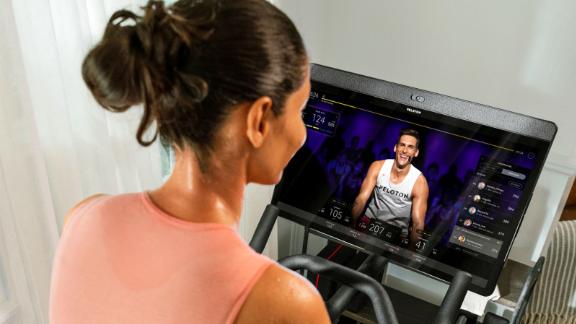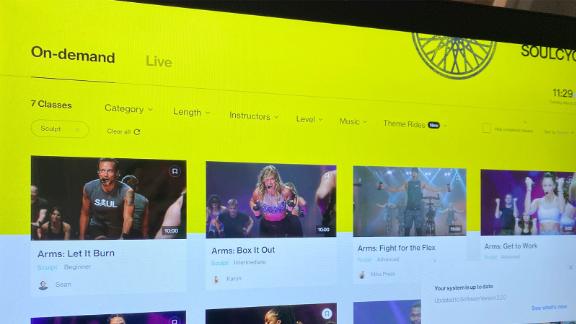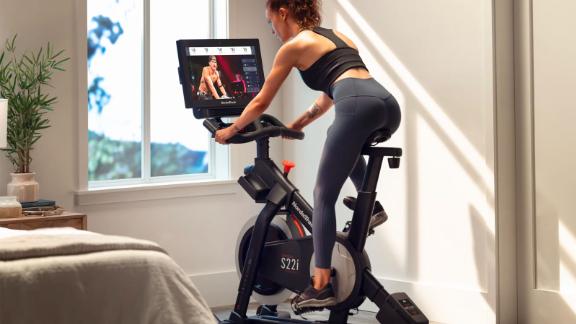[ad_1]
CNN —
Smart bikes — indoor exercise equipment with a built-in screen to display and track cycling workouts — aren’t exactly cheap. So to help you decide which machine is the best investment for you, we spent several months clipped in, tapping back and turning up resistance on the five best bikes on the market. These three stood out the most:
Best smart exercise bike overall
The Peloton Bike+ came out on top (but honestly, just barely) due to its sturdy construction, variety of knowledgeable, inspiring instructors and many high-quality off-the-bike classes. It's a great something-for-everyone buy.
Best smart exercise bike for music lovers
If you love to spin to the beat of the music, you'll love SoulCycle the most. It's better for out-of-the-saddle riding, and the instructors are incredibly magnetic, motivating, cultlike leaders in the best way possible.
Best smart exercise bike for scenic rides
The NordicTrack S22i bike's workouts are addictive and efficient, and we were truly transported by the travel rides. Want to bike (with a trainer) up the slopes of Mount Fuji? Or through Patagonia with a life coach? This is your bike.

Peloton
Peloton has been at it the longest and has had the most opportunity to optimize the category and the experience. The bike lives up to the hype and came out on top in our overall testing.
We appreciated how the bike seamlessly syncs with the Apple Watch, launching the “indoor cycle” workout tracker when you pair before a class, letting you know how hard you’re working throughout and then stopping when the class stops. (As of our testing, Peloton was the only bike that synced with the Apple Watch at this level, but we know it’s on a few of the other bikes’ road maps.)
We also loved how leaderboard-motivated riders can seemingly find a live riding pack every one to five minutes in the new “sessions” feature regardless of when the class first aired, and how you can really make sure you’re working as hard as the instructors want you to work with very clear resistance, output and cadence numbers.
Peloton, at press time, had just launched a “strive” score, which uses the readings from your heart rate monitor to deliver a score based on how much time you spend in each of the heart rate zones — the higher the zone, the more your score goes up. It’s a great way to compare your performance across workouts whether you’re on the bike or on the mat.
There were misses, but not many: In about 5% of our rides, the instructors would call a cadence or resistance range that wouldn’t reflect accurately on the display, or there would be an annoying delay in the readout, but for the most part it worked perfectly. (You can also select an “auto follow” feature where the instructor sets the resistance, but we didn’t love it.)
The ability to flip the screen around, set up a yoga mat and do off-bike workouts like barre, Pilates, yoga and meditation live or on demand with the same excellent instructors completes its category dominance. The “Works” Bike+ — the model we tested — is $2,795 and comes with 2-pound weights, shoes, a bike mat, a yoga mat and a resistance band, though it was a little annoying to have to skip over classes where the instructor was using a different kind of resistance band than what actually came with the bike, and/or heavier weights. In those cases, you’ll need to supply your own.
Peloton offers a ton of daily live rides, and any of those rides immediately then go on-demand so you can take them at your leisure later. Peloton also just started offering guided scenic rides, but other bikes were better at this. Another negative: You may have to wait to get your hands on a bike; although Peloton is working on the issue, shipping times are extremely lengthy.

Liz Zack
The SoulCycle bike was by far the sturdiest of the bikes we tested. If getting out of the saddle a lot or doing the SoulCycle sway as you power up hills is your thing, this is your best bike match.
But even more impressively, the instructors here are next level. If you miss leaving your in-person spin class with tears of joy streaming down your face, having experienced a life epiphany, thanks to the driving beat and sage counsel of these aerobic leaders, then there will be no substitute for you.
SoulCycle classes are also all about riding to the beat of the music, which is a blessing and a curse. It’s the greatest motivator: You will certainly be pushed to stay at the right cadence, but alternatively you may feel like you can’t get your legs spinning fast enough. Like other bikes in our testing group, many rides are themed around a playlist, which you can preview before you ride, but only Soul Cycle is so focused on spinning to the music throughout the class. At the end of every session you’ll get a “beat match” score, which tells you how often you were successfully pedaling to the beat.
What’s a little more challenging on the SoulCycle bike than on our other two winners is getting the resistance right. Instructors will make requests for quarter-turns, or a “couple big turns” to the knob, but we were never sure we were hitting exactly what was being asked. Some people might not be bothered by this slight ambiguity, but it’s a thing.
You can also select a free ride option where you can stream Netflix, Disney+, Prime Video or your own music. Like the Peloton, you can ride live or on demand, and the SoulCycle bike also comes with hand weights.

NordicTrack
NordicTrack SS2i
We were not prepared to love this bike as much as we did. One of its biggest differentiators is that it auto adjusts resistance and incline as you ride in a way that naturally echoes the terrain you’re covering. Although Peloton offers an auto resistance option, the NordicTrack is the only bike to feature both auto resistance and auto incline. This means you don’t have to do a thing (except keep up) as you exercise. You know exactly how hard your trainer wants you to work at any given moment, and they’ll also call out RPMs or a cadence number so you know how fast you need to pedal.
The ride itself is smooth, and since the bike adjusts when the coach wants you to work harder (or you go up a hill) it really maximizes every second of your workout (no moments lost fiddling with knobs).
NordicTrack leverages the excellent iFit studios and trainers and, as a result, the other real superlative here is its coached scenic rides. Peloton and SoulCycle have versions of scenic rides too, but the NordicTrack is the clear leader in this category. Although Peloton is beginning to invest in trainer-led scenic rides, the vast majority of them are just you pedaling by yourself against a picturesque backdrop. Conversely, NordicTrack’s rides are the real deal. You’re out there following your trainer, a world-class cyclist/trainer (also on a bike), leading you through a gorgeous (and likely hilly) part of the world, from cobblestoned southern France to Moab, Utah, and every beautiful bike route in between. There’s nothing quite like learning about Tour de France etiquette while spinning on that exact stretch of road, or like whizzing by a little Argentinian pension as you bike through jaw-droppingly gorgeous Patagonia. New travel series get added weekly and include 10 to 20 different workouts depending on the destination.
Because you’re pedaling through real life, the class lengths are also slightly irregular in a “real” way — many are 22 minutes or 38 minutes instead of the round 30-, 45-minute durations of the competitors.
The NordicTrack also comes with 2-pound hand weights and a built-in fan trained on your face, which certainly came in handy.
The drawbacks are that the UX and search functionality are not quite as clear as the other two winners, and as a result it was more challenging than it needed to be to seek out the right length, level and instructor that we wanted. Unlike the SoulCycle and the Peloton, the NordicTrack doesn’t come with clip-in pedals, so you’ll have to purchase those if they’re your thing.
We evaluated the five smart bikes over a period of more than six months. We solicited input from both male and female riders with varying levels of fitness and previous spin experience. We rode each bike for at least three 30-minute sessions and took at least one additional off-bike class like barre or yoga, if offered. In most cases we rode much, much more than this — at least three times a week for six months. We rated everything from how long it took to put the bike together (if applicable) to the variety and quality of the classes, to how easy it was to navigate the app software. We evaluated how sturdy the frame was for in and out of the saddle rides, how well you could track your exertion level and how compelling (or annoying) the instructors were. In total, we became experts on these five machines and in the process (in addition to a healthy diet) lost a ton of weight.
Here are the categories we evaluated each bike against:
Workouts
- Quality of programming/instructors: We know that the classes and the instructors make the experience and weighted this heavily.
- Number of classes/levels/lengths: The more variety the better so all types of exercisers could get their fix.
- Variety of spin classes (music, studio, free ride, travel): Does this bike work if I love country, ‘90s hip-hop and also southern Spain?
- Variety of classes beyond spin (barre, strength, yoga, meditation): We looked at what else we could do with the app off the bike, and how aptly this bike could be your 360 exercise solution.
- Ability to track workouts/progress: We evaluated how well the app captured how far you’d come and how you performed each ride.
- Ability to sync with other devices: Connectivity to heart rate monitors was a great added benefit for many bikes.
- Accountability and community features: How does the experience encourage you to take your next ride? How well can you connect with other riders? Earn badges?
Ride
- Levels of resistance: We looked at the range of resistance options.
- Ability to modulate the bike to match instructor direction: How easily could riders get the workout the coach was designing for us?
- Ease of switching between resistance levels: How much effort was involved to modulate difficulty levels?
- Change between levels: When we did modulate resistance, was there a noticeable change?
- Smoothness of ride: We took into account how smooth the ride was, on both “flat roads” and in more challenging parts of the workout.
- Stability of bike/ride: We evaluated how sturdy the bike felt both in and out of the saddle with both calm and vigorous riding.
Adjustability
- Adjustability of the seat, pedals and handlebars: We evaluated the ease and range of adjustability of all the movable parts.
- Can people of different heights/weights get a proper fit?: We looked at the range of heights and weights that the bike could accommodate.
Build
- Ease of assembly: For those that were self-assembled, we evaluated how long it took to remove the bike from the packaging, review the instructions and assemble.
- Material/durability: We evaluated how stable and durable all elements of the bike were from the seat to the tablet to the handlebars and pedals.
- Size: We evaluated how much space the bike takes up overall.
- Weight: We assessed how easy it was to move the bike around.
- Warranty: We checked the length of warranty on each machine.
MYXfitness Plus ($1,499, plus $29.99/month membership; myxfitness.com)
This bike was certainly a bargain, with the least expensive base price in the group and a TON of included extras: a six-piece weight set, kettlebell, foam roller, resistance band and yoga mat. It’s an insta-gym. It also comes with a Polar heart rate tracker to keep track of how hard you’re working. We also liked that you can get the MYX in black/deep blue or in white, which is kind of cool and a differentiator, especially since so many of these bikes now take up residence in our living rooms. The negatives were unfortunately around the classes and the instructors themselves. None were as spectacular as the winners’ classes, which is such an important part of the smart bike experience, and although you could pick from a few music options for each class, this wasn’t a real advantage because as a result the instructor was never synced to the beat or inspired by what was playing. It was…off.
Echelon Connect Ex-5s ($1,599, plus $39.99/month membership; echelonfit.com)
Although we loved how the instructor roster here included a few normal-bodied and (gasp!) older instructors, the classes were also not at the same level as our winners. One of the most compelling elements of this bike, however, is that you can use it to ride to other apps; in fact, considering its lower cost, many riders buy this bike and the Peloton monthly subscription and hack their way to cheaper Peloton workouts. The setup for the Echelon is also no joke — the bike comes in a box and it took us almost four hours to put it together from unboxing to plug-in. Two times during the process we needed to call in reinforcements to help, and our initial bike actually had a defect that meant we couldn’t change the resistance. The replacement bike resistance worked normally. Overall the lower price tag here meant a generally less optimal experience, with a bike that wobbled a bit out of the saddle and couldn’t compete with the classes of the winners, even though Mario Lopez has joined its fitness ranks.
Source link
[ad_2]
source https://earn8online.com/index.php/305682/best-smart-exercise-bikes-in-2021/
No comments:
Post a Comment